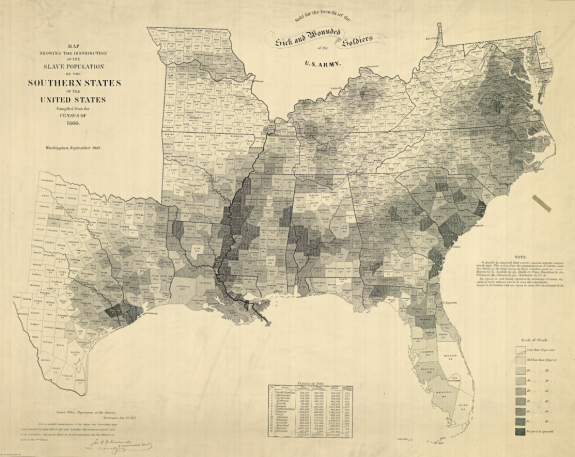The NYT, via Flowing Data, brings this map to our attention:

Makes you wonder about all sorts of overlays, doesn’t it?
The NYT describes its provenance:
The 1860 Census was the last time the federal government took a count of the South’s vast slave population. Several months later, the United States Coast Survey—arguably the most important scientific agency in the nation at the time—issued two maps of slavery that drew on the Census data, the first of Virginia and the second of Southern states as a whole.
And, as always, the map tells you about more than geography:
The map reaffirmed the belief of many in the Union that secession was driven not by a notion of “state rights,†but by the defense of a labor system. A table at the lower edge of the map measured each state’s slave population, and contemporaries would have immediately noticed that this corresponded closely to the order of secession. South Carolina, which led the rebellion, was one of two states which enslaved a majority of its population, a fact starkly represented on the map.
Conversely, the map illustrated the degree to which entire regions—like eastern Tennessee and western Virginia—were virtually devoid of slavery, and thus potential sources of resistance to secession.
Much credit to Susan Schulten, the author of the NYT piece.  She’s a history professor at the University of Denver and the author of “The Geographical Imagination in America, 1880-1950.â€

Scott Nolan
It is very interesting how things have both changed and remain the same after 150 years.
West Virginia decided not to leave the Union, and as Nina Simone says: “Mississippi God Damn!”
Massive immigration is gradually changing things in North Carolina, Florida, Virginia, and Texas as they all get to be a little more cosmopolitan and melting-pot-like.
Sneezewhiz
If you look closely at western North Carolina, you can see why there were no Black people depicted in the fictional town of Mayberry in the “Andy Griffith Show.”
Not only were these areas “potential sources of resistance to secession,” they actually resisted. The western 1/3 of Virginia broke away and formed a new state. Northeastern Alabama actively resisted attempts to draft soldiers for the Confederate army and pay taxes. Georgia had repeated failed votes to secede and was able to do so only by fraud.
The Civil War was 100% about slavery. http://www.washingtonpost.com/wp-dyn/content/article/2010/12/26/AR2010122601696.html
Paulie Coconuts
First of all the war was about about tariffs (aka taxation.) As usual, money is usually the root of all things like this.
Second of all, West Virginia was carved out of Virginia by the union out of necessity. Remember John Brown’s raid on the Union armory and arsenal at Harpers Ferry, VA?
The practical reason was that it wasn’t prudent to have the Union capital half surrounded by a seceded state (Virginia to the west and south). Maryland to the north and east was probably a dicey proposition but luckily it stayed with the union. Remember the plot to assassinate Lincoln was hatched in Maryland and I think the conspirators were half VA half MD folks.
From Wikipedia: “The new state was admitted to the Union on June 20, 1863, and was a key Civil War border state. West Virginia was the only state to form by seceding from a Confederate state…”
Paulie Coconuts
oh and thirdly…
Congrats to everyone still fighting the Civil War.
Not the re-enactors, you know who I am talking about (on both sides).
Please read “Confederates In The Attic” by Tony Horwitz and then get over it.
http://www.amazon.com/Confederates-Attic-Dispatches-Unfinished-Civil/dp/067975833X
sneezewhiz
Paulie, you have been misinformed.
On March 21, 1861, Alexander Stephens, the Confederacy’s vice president, gave what came to be known as the “Cornerstone speech” in which he declared that the “proper status of the Negro in our form of civilization” was “the immediate cause of the late rupture.”
Stephens went on:
“Our new government is founded upon exactly the opposite idea. Its foundations are laid, its cornerstone rests, upon the great truth that the Negro is not equal to the white man; that slavery subordination to the superior race is his natural and normal condition. This, our new government, is the first, in the history of the world, based upon this great physical, philosophical and moral truth.”
This is a matter of historical fact and for anyone to continue to insist otherwise is to render his opinions irrelevant. It’s like believing the Earth is flat.